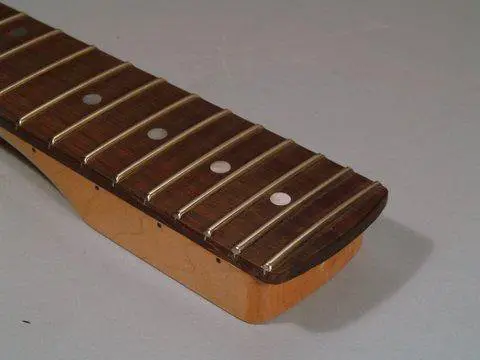Every guitarist has a moment when they consider changing the neck of their guitar. We shouldn’t be surprised that many people want to know if it is possible to replace a guitar with a longer neck. Like replacing a 21-fret neck with 22 or 24. Hey, worry no more. I got you covered!
It is entirely possible to switch a 21-fret neck for a 22-fret neck on the majority of guitar models. Some necks include so-called fingerboard extensions since they were made specifically to serve this function.
Remember that the reason a guitar neck with 22 frets has a slight overhang is that these necks are designed to be interchangeable.
In the rest of this article, I would be expanding on this question and also answering other intriguing questions as regards fret neck installation and fit. Stay with me!
Also Read: Guitar Neck Binding: Benefits, Downsides & Refreting Guide
Can You Replace Guitar With Longer Neck? (21 Fret Neck With 22 or 24)

Many 22 or 24 fret guitars have overhang at the edge – allowing it to fit regular necks that maybe created for 21 frets.
You should be able to replace a guitar neck with different fret counts – many guitar necks are interchangeable regardless of number of frets. There are even some necks that possess so-called fingerboard extensions and are designed intentionally for this purpose.
If you’ve noticed the little overhang on the 22 fret guitar neck, know that it’s made because 21 and 22 fret necks are interchangeable.
Take a quick glimpse over the differences between Strat’s that have 21 and 22-fret necks. The only thing you will notice is that the 22-fret neck demands a little overhang. Also, the scale of the neck doesn’t differ at all.
But the main problem here isn’t even whether a 24-fret neck can be fitted on a body designed for a 22-fret neck. If the scale length is 25.5″, the 24-fret neck will be slightly longer.
If mounting it on a 22-fret body, you would either have to move the bridge or acquire extra-long saddle adjustment screws to make up for the nut’s distance.
The scale length of a guitar neck with 24 or 22 frets is usually the same – usually 25.5”. But the most important thing to make sure of when altering the number of frets on your guitar is that the 12th fret is exactly in the middle of the neck and bridge.
To achieve this, measure the distance from the bridge to the 12th fret and compare it to the measurement from the neck to the 12th fret. If the distance is the same, that means that the two are compatible and replaceable.
A more complicated response to this question would be that, you can install longer or shorter necks as long as the distance between the nut and the bridge with the new 22-fret neck won’t change (or the change will be minimal enough that you can set the octaves with changing the bridge).
However, if the length would considerably change and sure, even a single fret adjustment will be noticeable—then you shouldn’t do it. Alternatively, you can, but be prepared for the guitar to sound a little strange.
Is More Fret Better? (21 vs 22 vs 24 Frets)
More frets is not always better, in most cases. The 23rd and 24th frets are rarely used in songs, and if you don’t play metal, you’ll probably never even approach the 20th fret.
More frets mean you can play more notes without having to use the higher strings. Though there could be situations in which playing specific tunes truly need the 23rd or 24th fret.
Generally, there is not a set of frets that will categorically improve the tone and playability of your guitar. There are simply frets that will be more or less suitable for you. So it depends on what you play and how you like it.
Do 22 Fret Guitars Sound Better? (Longer Neck)

Number of frets can surely influence the tone of the guitar
A guitar’s tone can be influenced by the number of frets it has. 22-fret guitars typically have a fuller, warmer tone because the neck pickup is installed farther from the instrument bridge, giving them a “fatter” sound.
They are therefore appropriate for genres of music that require clearer tones, such as jazz, blues, and others.
Some guitarists favor the feel of a 22-fret guitar over the fact that it sounds better. They have a shorter neck, so you can play lower notes and open chords without having to reach as far down the fretboard.
For instance, the sound of the neck pickups will alter if you compare two guitars with the same specifications but 22 and 24 frets, respectively.
Because a guitar with 22 frets has a shorter fretboard without the two extra frets, the neck pickup can be positioned further from the guitar’s bridge.
In contrast, a 24-fret will have less space for the neck pickup on the body without lengthening the scale, forcing it closer to the bridge pickup.
Generally, the 22-fret guitar gives you two wider tonal extremities: the bigger, bassier and livelier sound of the neck pickup and the crisper, cutting edge of the bridge pickup.
The difference between neck and bridge pickup tones on a 24-fret guitar is slightly more understated, and enough for some guitarists to opt for the sonic range of 22 frets.
Even some extremely powerful shredders, like Joe Satriani and Eddie Van Halen, still favor 22-fret guitars. So if you are looking for a guitar that can deliver a nice jazz tone, then a 22-fret will be superior to a 24-fret guitar. This goes for the classic Strat neck pickup tone too.
Do You Need More Than 21 Frets?

There’s no clear need of more than 21 frets
Actually, no. You rarely need more than 21 frets. The 23rd and 24th frets are rarely used in songs, and if you don’t play metal, you’ll probably never even approach the 20th fret.
And on most guitars, unless you have a spectacular double-cutaway body design and an extremely flat neck heel, it’s really difficult to even reach these frets.
Hardly anyone ever uses past the 20th fret. To get around this, guitarists have developed a technique whereby players with strong enough fingers may bend a string at the 21st fret to make it sound like the 24th fret. All you need to do is simply bend the 21st even if you require 22.
Also Read: Changing Guitar Fretboard & Neck 101: Guide, Cost & FAQs
FAQs
Q: Why Does Fender Only Have 21 Frets?
The 1950s, 1960s, and 1970s Stratocasters all had 21 frets, making them the standard for Stratocasters today. A 21-fret neck was significantly quicker to put together, thus that is how they were constructed. to enable Fender to produce and market more guitars.
Since 21 frets could fit on the neck before the neck pocket ran out, that is how Fenders were initially constructed. Additionally, it sets the neck pickup’s pole piece exactly where the 24th fret would be, putting it on a nice harmonic node.
There are still many electric guitars produced with 21 frets, although 22 frets are becoming the norm. Any guitar resembling ’50s, ’60s or ’70s specs (unless hot-rodded) will most likely contain 21 frets – that goes for both Telecaster and Stratocaster models. Simply said, guitarists adore the vintage aesthetic.
Additionally, if you use the 21 frets, you get that much-coveted vintage tone from both the neck pickup and middle position, if you’ve got one. The deeper sound of the neck pickup is even more noticeable than on a guitar with 22 frets.
Q: Does Fender Make a 24-Fret Neck?
Fender has made 24-fret guitars. Fender Stratocasters with 24 frets are available, though most strat’s only have 22 frets.
Fender’s Strat for the Metal Age was the HM Strat. 24 frets, a floating bridge, locking tuners, and Seymour Duncan humbuckers with a five-way switch that separates the coils are all features of this guitar. This guitar sounds and is in excellent condition.
It has a lovely quilted maple body, Abalone fret markers, and a Case. It has minor buckle rash, minor fret wear, one nick on the back of the body, and one nick on the front of the headstock.
Although the majority of Fender Stratocasters come equipped with either 21 or 22 frets. Whether or not a strat’s is 21 depends on the model. The Fender HM Strat that has 24 frets is very much an exception.
Q: Can You Put a 22-Fret Neck on a Strat?
A 22-fret neck should fit a Strat with no issues. The extra fret and overhang add only. 300″ (3/10ths of an inch). The pickguard thickness under the overhang may also be a problem.
The truth is that any scale neck can be attached to anybody as long as it fits in the pocket and is straight. Of course, the intonation needs to be reset.
Speaking of acoustics, you might experience a problem, and the location of the present bridge might also be problematic. However, it’s simple for an electric-equipped with merely adjustable saddles on the bridge.





